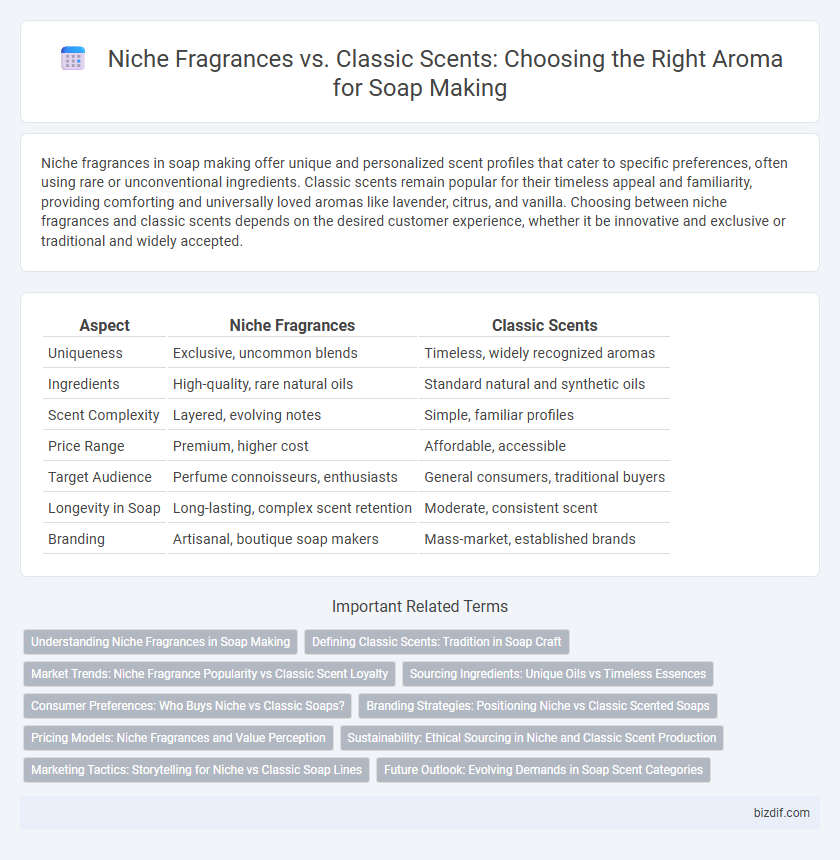Niche fragrances in soap making offer unique and personalized scent profiles that cater to specific preferences, often using rare or unconventional ingredients. Classic scents remain popular for their timeless appeal and familiarity, providing comforting and universally loved aromas like lavender, citrus, and vanilla. Choosing between niche fragrances and classic scents depends on the desired customer experience, whether it be innovative and exclusive or traditional and widely accepted.
Table of Comparison
| Aspect | Niche Fragrances | Classic Scents |
|---|---|---|
| Uniqueness | Exclusive, uncommon blends | Timeless, widely recognized aromas |
| Ingredients | High-quality, rare natural oils | Standard natural and synthetic oils |
| Scent Complexity | Layered, evolving notes | Simple, familiar profiles |
| Price Range | Premium, higher cost | Affordable, accessible |
| Target Audience | Perfume connoisseurs, enthusiasts | General consumers, traditional buyers |
| Longevity in Soap | Long-lasting, complex scent retention | Moderate, consistent scent |
| Branding | Artisanal, boutique soap makers | Mass-market, established brands |
Understanding Niche Fragrances in Soap Making
Niche fragrances in soap making offer unique, artisanal scent profiles derived from rare or natural ingredients, setting them apart from classic scents that typically feature familiar floral or citrus notes. These specialized fragrances enhance the sensory experience by providing complexity and exclusivity, appealing to consumers seeking personalized and distinctive soap products. Understanding the composition and market demand for niche fragrances enables soap makers to create premium, high-value offerings that stand out in a competitive marketplace.
Defining Classic Scents: Tradition in Soap Craft
Classic scents in soap making embody timeless traditions, featuring fragrances like lavender, sandalwood, and rose that have been cherished for generations. These scents evoke familiarity and comfort, often associated with heritage and natural ingredients passed down through craft techniques. The enduring popularity of classic fragrances reflects their versatility and ability to harmonize with various soap bases and formulations.
Market Trends: Niche Fragrance Popularity vs Classic Scent Loyalty
Niche fragrances in soap making are experiencing a surge in market popularity due to consumer demand for unique, artisanal scents that offer exclusivity and personalized experiences. Classic scents like lavender, rose, and sandalwood maintain strong loyalty among traditional buyers who prefer familiar, timeless aromas associated with relaxation and comfort. Market trends indicate a growing coexistence where niche fragrances capture younger, trend-driven audiences while classic scents secure enduring trust from long-term users.
Sourcing Ingredients: Unique Oils vs Timeless Essences
Niche fragrances in soap making utilize rare and exotic essential oils sourced from specific regions, offering distinctive and complex aromatic profiles that appeal to niche markets. Classic scents rely on timeless essences such as lavender, rose, and sandalwood, often derived from well-established suppliers with consistent quality standards. Sourcing unique oils demands meticulous authentication and sustainable harvesting practices, while classic essences prioritize reliability and broad consumer recognition.
Consumer Preferences: Who Buys Niche vs Classic Soaps?
Consumers seeking unique and personalized experiences tend to purchase niche fragrance soaps, drawn by their exclusive and often artisanal scent profiles. Classic soap buyers prefer familiar and time-tested scents, valuing comfort and tradition in everyday hygiene products. Market data indicates niche fragrances attract a younger, trend-conscious demographic, while classic scents maintain strong appeal among older consumers and those prioritizing reliability over novelty.
Branding Strategies: Positioning Niche vs Classic Scented Soaps
Niche fragrances in soap making emphasize exclusivity and unique scent profiles, appealing to discerning customers seeking artisanal and personalized experiences. Classic scents leverage familiarity and timeless appeal, targeting a broader market through consistency and trusted associations in branding. Positioning niche soaps involves storytelling around rare ingredients and craftsmanship, while classic scented soaps rely on brand heritage and widespread recognition to drive consumer loyalty.
Pricing Models: Niche Fragrances and Value Perception
Niche fragrances in soap making often command higher prices due to their unique scent profiles and limited availability, which enhances perceived value among discerning customers. These artisanal scents are crafted with rare essential oils and exclusive blends, differentiating them from classic scents commonly found in mass-market products. The pricing model for niche fragrances leverages exclusivity and the emotional connection to scent, justifying a premium that aligns with consumer expectations of luxury and individuality.
Sustainability: Ethical Sourcing in Niche and Classic Scent Production
Niche fragrances in soap making often prioritize sustainability through ethical sourcing of rare, natural ingredients such as wild-harvested botanicals and certified organic extracts, minimizing environmental impact. Classic scents typically rely on widely available, sustainably farmed raw materials and synthetic alternatives to ensure consistent quality while reducing deforestation and overharvesting. Both niche and classic scent producers increasingly adopt fair trade practices and transparent supply chains to support biodiversity and empower local communities.
Marketing Tactics: Storytelling for Niche vs Classic Soap Lines
Niche fragrances in soap making leverage storytelling that emphasizes artisanal craftsmanship, rare ingredients, and unique sensory experiences to create emotional connections with discerning consumers. Classic soap lines often utilize nostalgia and familiarity in their marketing narratives, appealing to tradition and trusted scents that evoke comfort and reliability. Effective campaigns for niche soaps highlight exclusivity and origin stories, while classic soaps focus on heritage and consistent quality to drive brand loyalty.
Future Outlook: Evolving Demands in Soap Scent Categories
Niche fragrances in soap making, characterized by unique and boutique aroma blends, are increasingly favored by consumers seeking personalized and artisanal experiences, signaling a shift from traditional classic scents such as lavender and vanilla. Market trends indicate a growing demand for natural, eco-friendly, and exotic fragrances infused with rare botanicals and essential oils, reflecting evolving consumer preferences towards sustainability and wellness. Innovations in fragrance chemistry and sustainable sourcing are expected to further diversify soap scent categories, driving growth in niche markets while classic scents maintain steady appeal among traditional buyers.
Niche Fragrances vs Classic Scents Infographic

 bizdif.com
bizdif.com